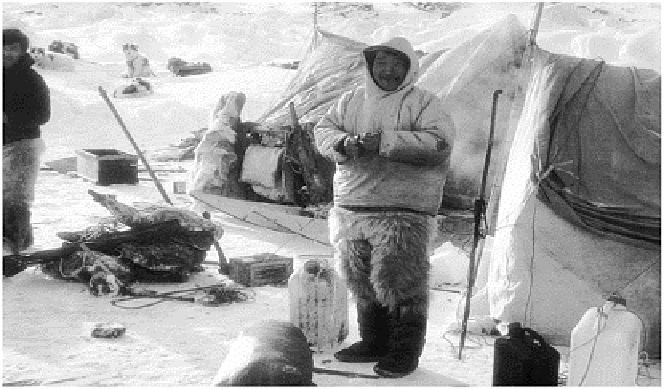Environmental Engineering Reference
In-Depth Information
nutrients, especially nitrates and phosphates, as the severest limit on productivity, given
the successful way that plants have adapted to cold. In Arctic terrestrial ecosystems, plant
production accounts for about 90 per cent of the energy flow, and decomposition in the
soil by invertebrates and microorganisms accounts for about 8 per cent, with the activity
of herbivores and carnivores contributing 2 per cent. In the Low Arctic in Alaska the
most productive ecosystems are wet sedge moss, cotton grass, dwarf shrub communities,
which yield 1·0-2·5 t ha
−1
yr
−1
above-ground net plant production. In these communities
nitrogen fixation by alder (
Alnus crispa
) and avens (
Dryas
spp.) is an important input,
with nitrates also being added by blue-green algae on wetter sites. Daily rates of
production during the short growing season are comparable with those of similar
communities in the temperate zone, ranging from 3 g dry matter per square metre in the
polar desert of the High Arctic to 225 g in wet meadows in Alaska. However, production
values in a small area may halve between the wetter and dryer parts of the arctic meadow,
and values of biomass may vary a hundredfold between hummocks and hollows 1 m
apart.
Data on energy flow in polar marine ecosystems are even scarcer than those for
terrestrial ecosystems (Plate 24.2). Figure 24.6 shows the pathways of energy flowing
through a marine food web in Lancaster Sound, Arctic Canada (75° N). The trophic-
dynamic model has been constructed according to the principles discussed in Chapter 22.
The model simplifies the complex reality of food chains, but it highlights the main
components (compartments) of the ecosystem and the principal energy pathways.
Phytoplankton, ice algae and kelp fix 89 per cent, 10 per cent and 1 per cent of the gross
primary production respectively. Primary production peaks sharply
Plate 24.2
Aboriginal peoples like this Inuit (Eskimo) hunting
party in Arctic Canada have traditionally been at the top of
the arctic food web, but their impact on ecosystems through
hunting has been sustainable. Processes of modernization,

